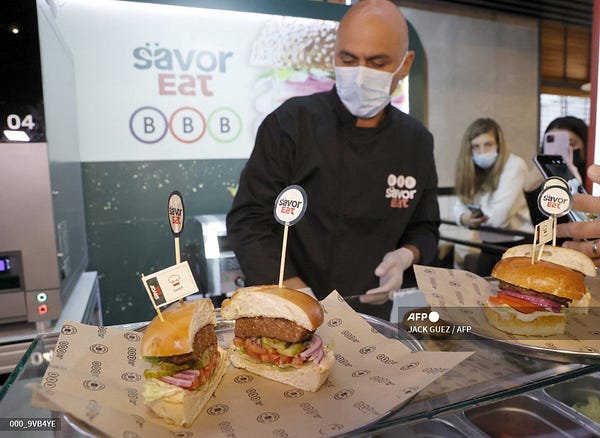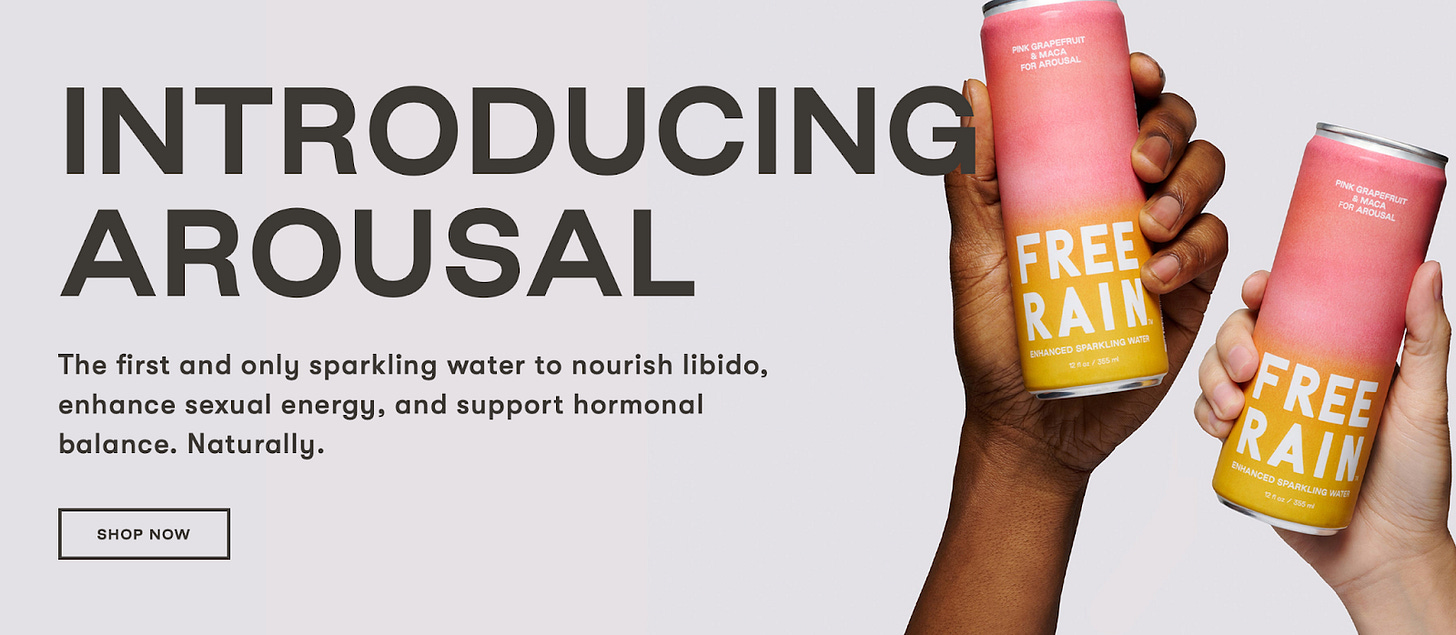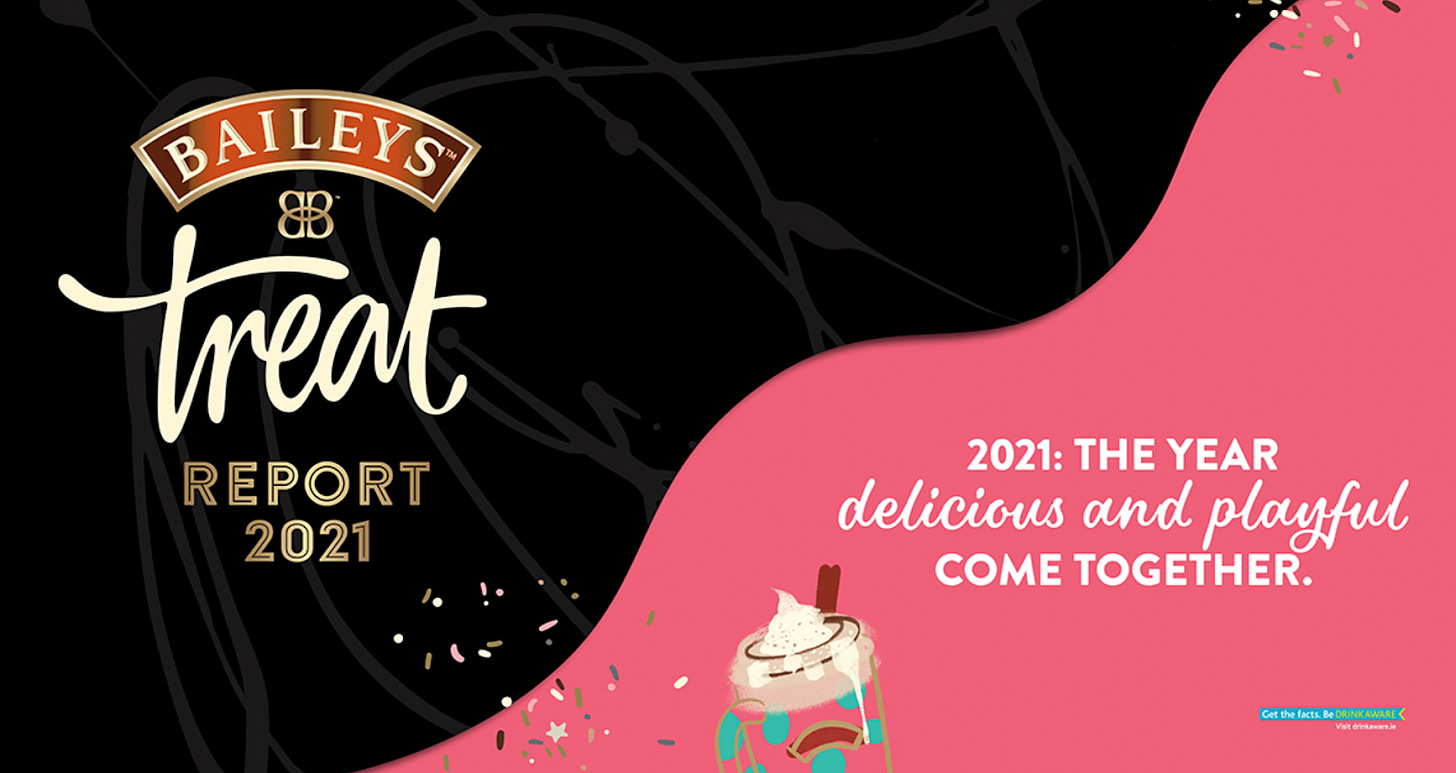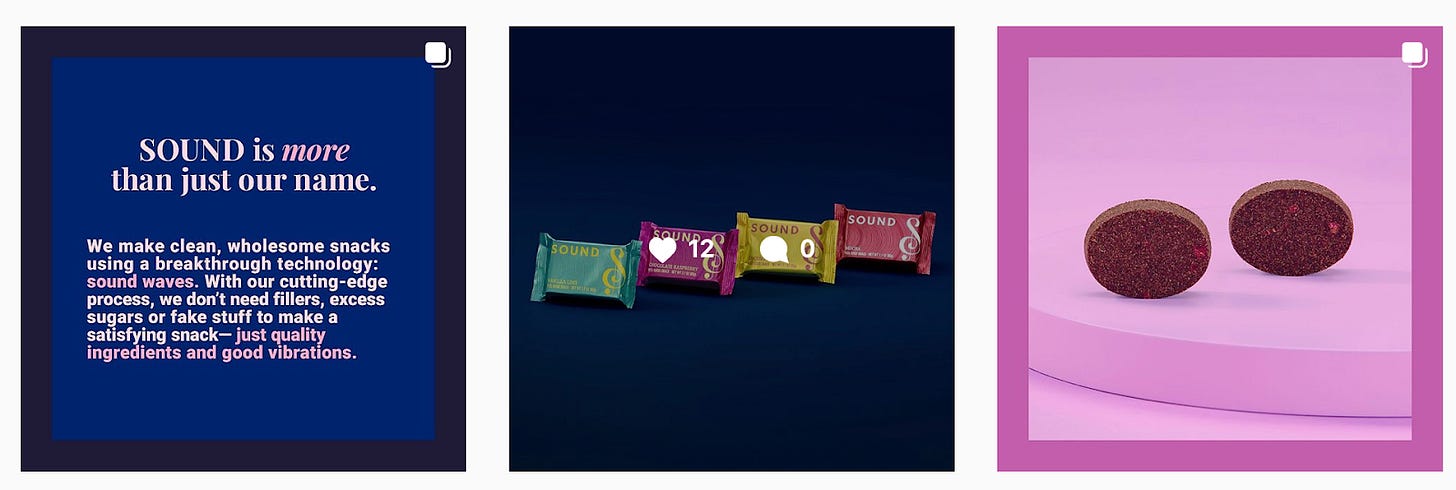Food Trends | 2022 Trends, Edible Flower Boom, Erotic Food, Infused Butter...
In the Spotlight
🔮 What food trends will shape 2022?
As the year begins, it is more important than ever to look ahead. What dynamics will drive the food market in the months to come? While Pinterest predicts the return in force of tea time or ancestral cuisine, other themes should continue to grow, such as veganism, fusion cuisine, ghost kitchens or the boom of alcohol-free food driven by the "rise of the sober curious" movement. Looking at our past editions and into the latest news, it's our turn to offer you our selection of the trends that should be the talk of the town in 2022.
360° experiential food. Stimulated by consumers eager for new sensations, food-related experiences continue to reinvent themselves, both offline and online.
Lockdowns, curfews, health restrictions... In recent months, consumers have deserted restaurants in favor of take-out. How can we encourage customers to return to these physical spaces? Using augmented reality, holographic menus developed by Hololamp or PeaAR... all high value-added experiences that could soon make a difference. And that's not counting experiments around the metaverse: last October, the Chipotle Mexican Grill chain opened its virtual restaurant on the Roblox game platform. Users were able to visit this digital space to pick up digital goodies but also a code allowing them to taste a free — and very real —burrito, thus renewing the brand's drive-to-store strategy. These new digital facets should also accelerate within food brands with, among others, the creation of more utilitarian NFTs emphasizing the community dimension.
At the same time, it is likely that the consumer experience will continue to stand out through surprising collaborations, atypical drops and increasingly surprising pairing operations, such as the partnerships between Barefoot and Oreo, or between Van Leeuwen and Kraft Mac and Cheese that were developed in 2021.
In short, always more unusual and always more innovative concepts carried by a booming Creator Economy. Delli, Demi, Stove, Mirepoi... These start-ups, whose goal is to help food content creators monetize their talents, are gradually coming out of their beta versions. At the same time, Netflix is getting ready to release the much-anticipated biopic on cooking guru Martha Stewart. This is enough to create aspirations and inspire ever more original and niche food offers... which should therefore be mainstream soon?
Hyper-personalization. Until now, food personalization has been limited to two main areas. On the one hand, the "simple" personalization consisting of putting a message, a name or an image on a product. On the other hand, the development of online questionnaires allowing access to recommendations based on fairly basic elements: allergies, weight, goals, etc.
It's time to move up a gear. In the near future, personalization should become more refined and more targeted in order to reinvent the way we eat every day.
To do this, brands can count on the democratization of DNA tests and home microbiota assessment. Startups are multiplying in this niche, like DayTwo, which has raised over $90M since its creation in 2015. Spearheading precision nutrition adapted to different metabolisms, the concept of this American company is based on a three-fold approach: a microbiota test, ad hoc recommendations via an AI-based application and tailored advice supported by diet experts.
Another promising avenue also seems to be the Internet of Food. For example, the Israeli company Lumen is marketing a portable device that integrates a sensor and a flow meter to determine the concentration of CO2 during a single breath. This indicator, linked to an application, is intended to serve as a recommendation for personalized menus to naturally promote fat burning and energy intake.
Similarly, 3D printing and robotics are beginning to offer interesting perspectives in the food industry. If Ripple Maker machines can print images on the foam of lattes or beers, the use cases now go beyond mere aesthetic customization. In Israel, a fast-food restaurant offers burgers prepared to order by a robot. Customers are invited to customize their recipe by choosing the amount of vegetable protein or fat in their steak, as well as its size and how its cooked.
“Functional food” starts making sense. In 2021, the term "functional food" has largely infiltrated the minds of consumers. But it is clear that the concept was until now a catch-all term for any product considered to be healthy. Thus, 2022 could be the time for a major clean-up and, above all, for a more structured approach.
To each pathology a dedicated food offer? Almost. In recent months, manufacturers have become more interested than ever in food combos to relieve certain health problems. If the giant Heinz is working on a cocoa-based drink called "Period", designed to soothe painful periods, DTC brands are also taking up the subject. In the Netherlands, Rooby is positioning itself as the first snack with anti-inflammatory components to relieve this type of pain. Chocobombes, on the other hand, focuses on sweets adapted to each trimester of pregnancy, as does Jolly Mama. Teatis, for its part, focuses on teas that allow diabetics to better control their glycemic index, while Muniq offers high-protein shakes. There has also been a boom in "gut health", which concentrates all the probiotic-based products on offer. This segment is very large and includes both DTC brands such as Uplift and its "happy gut cookies" and industrial offers such as Babybel, which enriches its famous cheese with these microorganisms that act on the intestinal flora. Special mention should be made of the American company WeTheTrillions, which delivers meals specifically designed for painful periods, fertility, menopause, anemia, irritable bowel syndrome and diabetes.
The alicamentation market is also developing for the benefit of mental health, a subject revealed by the pandemic. In the coming months, we should continue to see the development of drinks based on CBD and adaptogens like the products offered by Sunwick, Peak, Moodring, Drink Moment and Hop Wtr, along with the same dynamics for variants in the form of ice cream, snacks and other foods for adults and children like Cerebelly or Brainiac. The time is also ripe for the development of night food, as products designed for night-time cravings are being supplemented with adaptogens or melatonin to facilitate sleep, which is sometimes undermined by the health crisis. In a broader sense, we can also add the development of content such as ASMR food videos or "culinary therapy" sessions to one's therapy.
Feeling better inside and out also involves the rise of Beauty Food. Very popular in China, the trend is coming to the West: if gummies and beauty drinks first appeared in drugstores and on social networks, the phenomenon is now opening up to supermarkets and specialty stores, for example, Krumbled Foods' beauty bites or yoghurts with collagen and antioxidants. The offer is developing at such a speed that the Australian Beauty Food has created a dedicated online store for this market.
Moving towards a more sustainable food supply. Without any real surprise, sustainable food is emerging as a collective challenge and a way forward for the food industry, boosted by several dynamics.
Alternative proteins are a macro-trend that also take on a responsible character with formulations based on plants, insects or even algae. But if all segments are booming, one axis in particular seems set to explode: in-vitro cultivation. Meat, fish, foie gras, honey, eggs, even chocolate: get ready for an in-vitro surge.
In the same vein, the trend should accelerate even more in the area of consumer information. For example, expect to see more and more information about carbon emissions on product packaging and even on restaurant menus. In the United Kingdom, Foodsteps has created a database that lists the environmental impact of more than 1,000 ingredients: with this carbon label, the company aims to help consumers make informed choices and assist companies in identifying their environmental weaknesses.
But beyond this initiative, the entire packaging sector is reinventing itself. While biodegradable packaging made from algae or mycelium is becoming more widespread, Pernod-Ricard, for example, has brought forward its farewell to single-use plastic. The start-up Switch Eat, for its part, specializes in the design of edible packaging, a market that is expected to be worth $2.14 billion by 2030. And while No Evil Foods offers 100 percent compostable packaging printed with vegetable ink, Haven’s Kitchen has come up with a free recycling program for its pouches in partnership with Terracyle: simply request an envelope, fill out an order form and mail the empty package back. Dispatch Goods offers reusable packaging, and Culina sells its yogurt in cups designed, eventually, to grow flowers. And that's not to mention the success of bulk products.
These practices go hand in hand with the boom in anti-waste initiatives: cooking with leftovers, better understanding of expiration dates thanks to new technologies, promoting food bartering thanks to dedicated applications, looking out for good deals on unsold goods... More than just a trend, this consumption philosophy is also illustrated by the rise of upcycling, which consists of recovering materials or products that are no longer used in order to create superior quality products. Sir Kesington partnered with a hummus maker to source aquafaba and make a vegan mayonnaise from chickpea cooking water. Toastale makes its beer from surplus bread. Barnana has teamed up with Latin American farms to recover bananas that are too spoiled to be sold: dehydrated, they are transformed into snacks. The same concept applies to Spudsy, which makes chips from sweet potatoes that do not meet consumer standards.
Also noteworthy is the development of new crops at the local level. Thanks to diversification or specialization by regional producers and breeders, turmeric, ginger, goji berries and sweet potatoes are becoming compatible with a sustainable diet while meeting the growing appetite for world cuisine. In Germany, wasabi and quinoa are now being produced. In Switzerland, Niels Rodin is growing lemons. And you can now find Kobe beef in Austria.
All these trends are just a reflection of considerations around what is called "shopping by mission". On sites like Hive Brands, we shop according to our values. Education, environment, health...: the platform offers products linked to specific values. The GreenChoice application has used data from NGOs and third-party certifiers to rate 350,000 food products distributed at Walmart and Whole Foods, among others. Users can filter their searches based on 90 preferences: organic, palm oil free, low water footprint...
Strong Signals
🌹Say it with (edible) flowers.
If 2021 was the year of spices, 2022 could well be the year of flowers. With an average of 107K queries typed each month into Google worldwide, the term "edible flowers" has doubled compared to 2019. Calendula, begonia, oxalys, marigold, rose... Propelled to the forefront by the rise of vegan diets and the quest for new flavors, flowers are seducing people with their acidic, bitter, fresh or sweet notes. They also have the particularity of offering a colorful touch to the plates, a luxury not to be neglected in these dark times... and very much appreciated on Instagram.
Have you heard of the Slow Flower trend? More and more local producers are now also making the choice to open up to growing edible flowers, feeding a local market that respects the ecosystem and the seasons.
It must be said that the field of possibilities is vast, very vast. Fresh flowers can be used to decorate both sweet and savory dishes. Imprisoned in an ice cube, they enhance cocktails. Dried, they can be used in infusions, jams, breads and sauces. Gelled, they become edible works of art. Pressed or crystallized, they give relief to pastries. What about making them a distinctive signature? That's what Blushing Cook, a specialist in postal brownies made with pressed flowers, has decided to do.
Also on the horizon is the launch of Authored by the Sun next spring. On the agenda: a mystical universe made of infusions and regenerative floral tinctures. Enough to thrill the kitchen witches on Tiktok!
😛Erotic Food is rising
The post-COVID future will be hot, or it won't be. In an article published last December in The Guardian, physician and sociologist Nicholas Christakis — also a professor of social and natural sciences at Yale University — explains that pandemics tend to provoke "an increase in spirituality and abstinence." This period of crisis would be followed by a rebound effect characterized by a quest for social interaction and, by extension, a renewed libido. Get ready: the collective fever notice is scheduled for 2024.
Still, on the internet, culinary and sexual appetite seems to be on consumers' minds already. On Google, the semantics "sex" + "food" accumulate nearly 100K monthly requests while we are still in full epidemic peak. Enough to drive the nascent segment of the so-called erotic food into a frenzy.
First of all, let's mention the DTC brands whose ginger and maca-based products are accompanied by enticing marketing. Perfect examples of the phenomenon are the Free Rain drink in the United States and the "Virility Drink" from the Revv brand in China. Also on the menu, spreads and chocolates supposed to boost the libido like those of Phasey or Sext, whose bestseller "Orgy," infused with aphrodisiac herbs, is a hit on Tiktok. All to be washed down with a homemade sex coffee. And what about splooshing, a new ASMR trend mixed with food fetishism...
In France, La Quequetterie has been a hit since its launch during the pandemic. With its evocatively shaped pastries, the brand has nearly 100K followers on Instagram and has already opened four stores. A model that France does not have a monopoly on: let's mention, for example, Marbello Gaufres et Délices in Canada or Cake me Baby in the UK.
Something to inspire chefs? Several erotic concepts have emerged in recent years, including "Liaisons Gourmandes", whose objective is to focus on sensoriality through audio-gustatory experiences. Let's also mention Gola in London, which describes itself as an Italian restaurant "with a touch of aphrodisiac ingredients" and whose reservations, like an insider's secret, are made only via WhatsApp.
Let's leave the final word to the starred chef, Jacques Le Divellec: "The kitchen and the bedroom are very close to each other because gastronomy and sexuality are both a joy of living. They also have this in common: cooking cannot be done any way and neither can love." Duly noted... and see you in our next Valentine's Day newsletter.
Weak signals.
🧈We melt for infused butter.
With the pandemic, bread has experienced an unprecedented boom, A boom of bread machines but also of flours, yeasts and jams... While consumers took advantage of this extra time spent at home to reconnect with breakfast — which could also be a strong trend in 2022 — the phenomenon was so marked that it overshadowed another trend: that of infused butter.
But infused with what exactly? Cannabis, according to the 135K Google queries on the subject recorded worldwide last December. If THC, the psychotropic substance, is not legalized in France, it is nevertheless accepted in the form of flowers and leaves. Note that the butter does not escape the surge of the edible flowers...
On the competition side, several brands have launched in this niche. Let's mention the British Posh Cow and its whipped butter made with honey/cinnamon, Earl Grey/apricot or a version made with seaweed. This will add to the ranks of a market that, as we wrote a few months ago, already has many variations based on seeds, nuts, adaptogenic mushrooms or Ayurvedic herbs.
✨ Mystic Food.
Astrology, clairvoyance, numerology... At a time when the pandemic has exacerbated the need for spirituality, these practices are generating a renewed interest among the general public. In its reports, the mobile analytics startup Sensor Tower notes the growing use of apps related to these subjects, some of them brandishing scientific arguments to guarantee their seriousness, such as Co-Star which relies on NASA data.
Not surprisingly, the phenomenon is gradually spreading to other sectors, including food: on Google, worldwide, close to 10K queries are searched for each month related to the keywords "food + Zodiac". As a result, last year, the Australian company Fluffe launched a limited edition of its premium cotton candy, based on zodiac horoscopes. The same principle is used by the Italian tea brand Via Del Tè. On Twitter, last July, it was the Taco Bell chain that tried to match products with zodiac signs, even going so far as to make recommendations according to the signs of the Sun, the Moon and the Rising Sun! The trend is even infiltrating the bars of the trendiest palaces, since the very select Ritz in Paris has inaugurated a bar with 12 cocktails inspired by the zodiac signs.
This ambient neo-mysticism is also reflected in the explosion of demand for healing crystals with an average of 44.3K monthly requests on Google for "chakra stones" This trend has given ideas to some brands that now offer a sweet version of these stones. The Misaky brand has made a vegan, healthy and particularly realistic interpretation. Booze Dust sprinkles it on cocktails to — supposedly — avoid hangovers: a glittering effect reminiscent of the bling bling glitter cereals from OffLimits. In short, food sparkles with a thousand lights.
Short stories from the bar counter.
Much loved: the Baileys treat report is produced in collaboration with food futurist Morgaine Gaye and a panel of international experts. What's in it for us? Some comforting classics are set to make a comeback, like Snickerdoodles and chewy cookies with a cracked surface. On the other hand, have you ever wondered how the donut could be taken to an even more indulgent stage? Well, get ready to go Cremella crazy: a doughnut cut in half, filled with ice cream and topped with a shower of sprinkles and other toppings. Also worth noting is the boom in edible sprinkles, with a particular appetite for sustainable sprinkles. Purple corn ice cream and red beet brownies: chromatic choices should also have a bright future, as should sculptural cakes or those celebrating the wonders of nature.

Faced with the rise of night food, breakfast is going all out. Among the recently launched brands, many are inspired by the success of OffLimits, such as Surreal, or Groovies, which nevertheless stands out with cereals made from popped quinoa. The Real Cereal Company offers personalized boxes with associated toppings and coulis. Oats in Coats offers a range of oatmeal for children with fun and colorful packaging, while Upright Oats is also banking on oats... but in a drinkable version, packed with probiotics.
Supersonic food? According to website Spoonshot, while sound is already closely linked to the food world — notably via ASMR ― it could soon become a key component of manufacturing processes. Spoonshot thus cites the example of Dirt Kitchen, a brand of the Mondelēz International group, which has announced that it is testing a new, better-for-you snack bar: it is made in part thanks to ultrasonic energy, which allows ingredients to be combined without the use of binders or added sugars. This technology was developed by the Israeli company Torr FoodTech, in which the snacking giant has invested ( ed. note: this is its very first investment in a processing technology). This process would ensure a unique texture and a good conservation of nutritional value by freeing itself from thermal procedures. But this is not the only example. Sound Nutrition’s Sound Bites snacks, for example, are designed using high-frequency, low-amplitude sound waves that are supposed to gently vibrate the ingredients into the desired shape and appearance in a fraction of a second, again, without heat. A little revolution?

















